高中英语倒装省略
- 格式:doc
- 大小:26.50 KB
- 文档页数:3
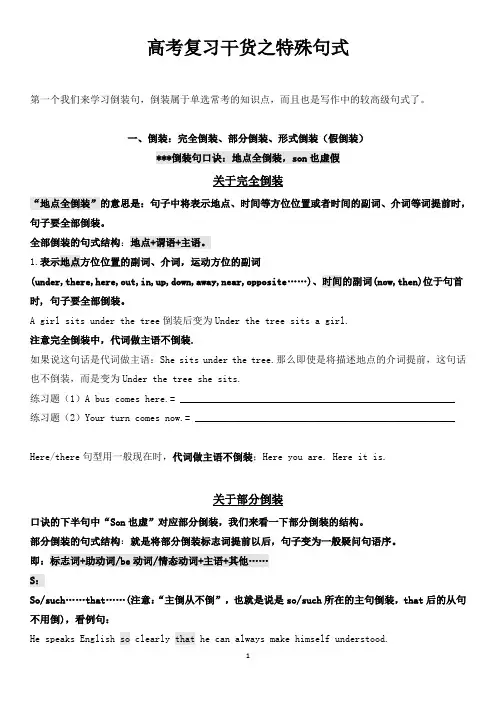
第一个我们来学习倒装句,倒装属于单选常考的知识点,而且也是写作中的较高级句式了。
一、倒装:完全倒装、部分倒装、形式倒装(假倒装)***倒装句口诀:地点全倒装,son也虚假关于完全倒装“地点全倒装”的意思是:句子中将表示地点、时间等方位位置或者时间的副词、介词等词提前时,句子要全部倒装。
全部倒装的句式结构:地点+谓语+主语。
1.表示地点方位位置的副词、介词,运动方位的副词(under,there,here,out,in,up,down,away,near,opposite……)、时间的副词(now,then)位于句首时, 句子要全部倒装。
A girl sits under the tree倒装后变为Under the tree sits a girl.注意完全倒装中,代词做主语不倒装.如果说这句话是代词做主语:She sits under the tree.那么即使是将描述地点的介词提前,这句话也不倒装,而是变为Under the tree she sits.练习题(1)A bus comes here.= _______________________________________________________ 练习题(2)Your turn comes now.= ____________________________________________________Here/there句型用一般现在时,代词做主语不倒装;Here you are. Here it is.关于部分倒装口诀的下半句中“S on也虚”对应部分倒装,我们来看一下部分倒装的结构。
部分倒装的句式结构:就是将部分倒装标志词提前以后,句子变为一般疑问句语序。
即:标志词+助动词/be动词/情态动词+主语+其他……S:So/such……that……(注意:“主倒从不倒”,也就是说是so/such所在的主句倒装,that后的从句不用倒),看例句:He speaks English so clearly that he can always make himself understood.=so是标志词,所以so clearly这个意群提前(举个例子来说意群:一辆出租车来了=来了一辆出租车,其中“一辆出租车”这几个字不能拆分,它就是一个意群),然后再将主句调整为上边说的部分倒装句式结构。
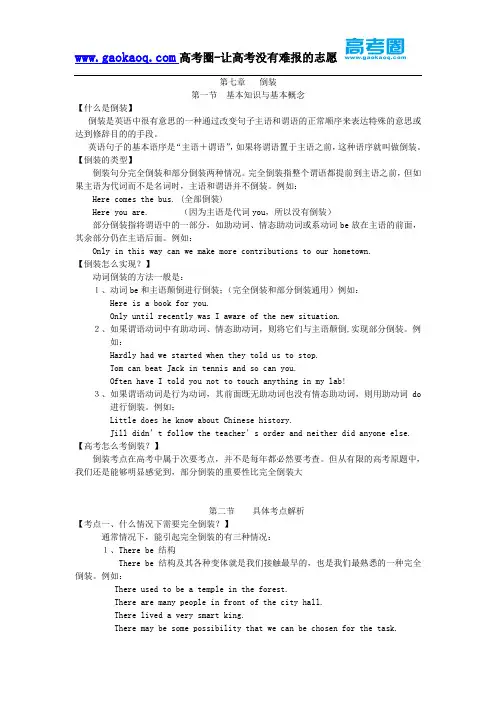
第七章倒装第一节基本知识与基本概念【什么是倒装】倒装是英语中很有意思的一种通过改变句子主语和谓语的正常顺序来表达特殊的意思或达到修辞目的的手段。
英语句子的基本语序是“主语+谓语”,如果将谓语置于主语之前,这种语序就叫做倒装。
【倒装的类型】倒装句分完全倒装和部分倒装两种情况。
完全倒装指整个谓语都提前到主语之前,但如果主语为代词而不是名词时,主语和谓语并不倒装。
例如:Here comes the bus. (全部倒装)Here you are. (因为主语是代词you,所以没有倒装)部分倒装指将谓语中的一部分,如助动词、情态助动词或系动词be放在主语的前面,其余部分仍在主语后面。
例如:Only in this way can we make more contributions to our hometown.【倒装怎么实现?】动词倒装的方法一般是:1、动词be和主语颠倒进行倒装;(完全倒装和部分倒装通用)例如:Here is a book for you.Only until recently was I aware of the new situation.2、如果谓语动词中有助动词、情态助动词,则将它们与主语颠倒,实现部分倒装。
例如:Hardly had we started when they told us to stop.Tom can beat Jack in tennis and so can you.Often have I told you not to touch anything in my lab!3、如果谓语动词是行为动词,其前面既无助动词也没有情态助动词,则用助动词do 进行倒装。
例如:Little does he know about Chinese history.Jill didn’t follow the teacher’s order and neither did anyone else. 【高考怎么考倒装?】倒装考点在高考中属于次要考点,并不是每年都必然要考查。
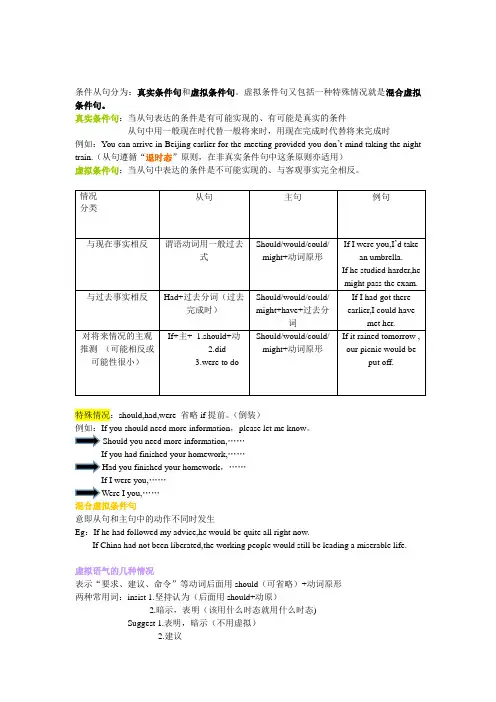
条件从句分为:真实条件句和虚拟条件句。
虚拟条件句又包括一种特殊情况就是混合虚拟条件句。
真实条件句:当从句表达的条件是有可能实现的、有可能是真实的条件从句中用一般现在时代替一般将来时,用现在完成时代替将来完成时例如:You can arrive in Beijing earlier for the meeting provided you don ’t mind taking the night train.(从句遵循“退时态”原则,在非真实条件句中这条原则亦适用) 虚拟条件句:当从句中表达的条件是不可能实现的、与客观事实完全相反。
特殊情况:should,had,were 省略if 提前。
(倒装)例如:If you should need more information ,please let me know 。
Should you need more information,…… If you had finished your homework,…… Had you finished your homework ,…… If I were you,…… …… 混合虚拟条件句意即从句和主句中的动作不同时发生Eg :If he had followed my advice,he would be quite all right now.If China had not been liberated,the working people would still be leading a miserable life.虚拟语气的几种情况表示“要求、建议、命令”等动词后面用should (可省略)+动词原形 两种常用词:insist 1.坚持认为(后面用should+动原)2.暗示,表明(该用什么时态就用什么时态) Suggest 1.表明,暗示(不用虚拟) 2.建议Eg.He suggested that a meeting be held to discuss the matter.The look on his face suggested that he was quite satiesfied with what I had done for him.Would rather+从句从句中的谓语动词用过去形式表虚拟。
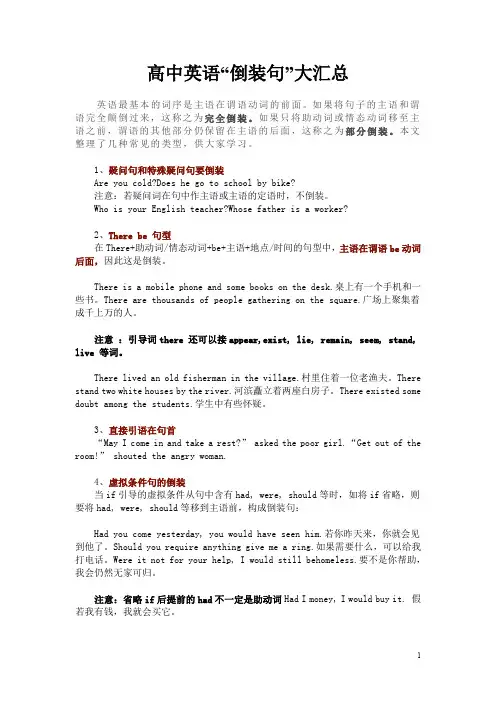
高中英语“倒装句”大汇总英语最基本的词序是主语在谓语动词的前面。
如果将句子的主语和谓语完全颠倒过来,这称之为完全倒装。
如果只将助动词或情态动词移至主语之前,谓语的其他部分仍保留在主语的后面,这称之为部分倒装。
本文整理了几种常见的类型,供大家学习。
1、疑问句和特殊疑问句要倒装Are you cold?Does he go to school by bike?注意:若疑问词在句中作主语或主语的定语时,不倒装。
Who is your English teacher?Whose father is a worker?2、There be 句型在There+助动词/情态动词+be+主语+地点/时间的句型中,主语在谓语be动词后面,因此这是倒装。
There is a mobile phone and some books on the desk.桌上有一个手机和一些书。
There are thousands of people gathering on the square.广场上聚集着成千上万的人。
注意:引导词there 还可以接appear,exist, lie, remain, seem, stand, live 等词。
There lived an old fisherman in the village.村里住着一位老渔夫。
There stand two white houses by the river.河滨矗立着两座白房子。
There existed some doubt among the students.学生中有些怀疑。
3、直接引语在句首“May I come in and take a rest?” asked the poor girl.“Get out of the room!” shouted the angry woman.4、虚拟条件句的倒装当if引导的虚拟条件从句中含有had, were, should等时,如将if省略,则要将had, were, should等移到主语前,构成倒装句:Had you come yesterday, you would have seen him.若你昨天来,你就会见到他了。
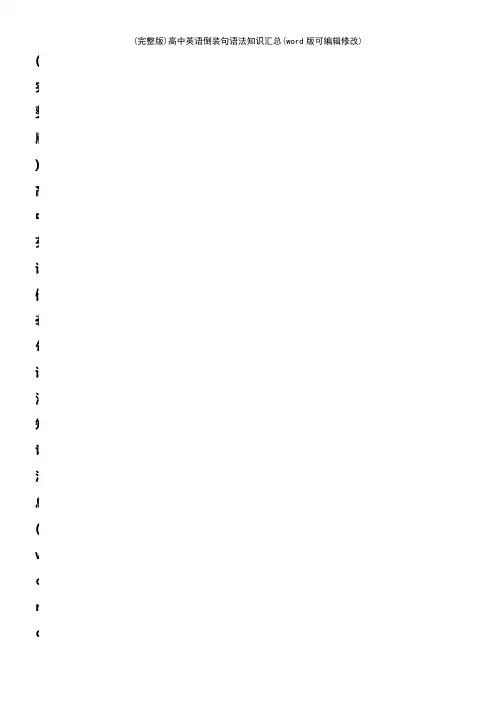
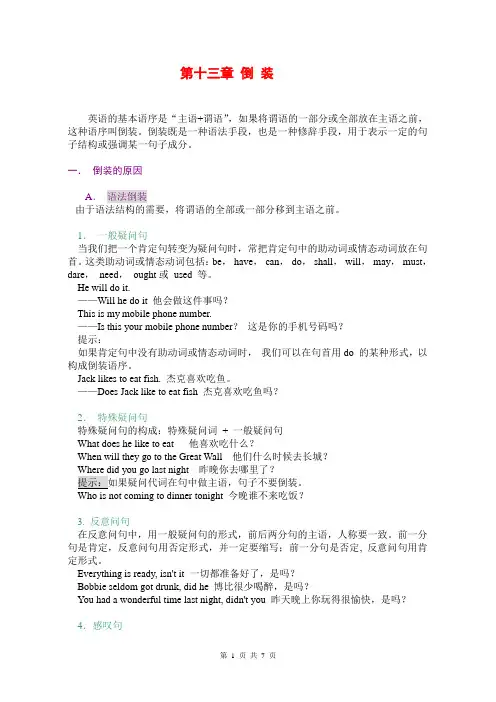
第十三章倒装英语的基本语序是“主语+谓语”,如果将谓语的一部分或全部放在主语之前,这种语序叫倒装。
倒装既是一种语法手段,也是一种修辞手段,用于表示一定的句子结构或强调某一句子成分。
一.倒装的原因A.语法倒装由于语法结构的需要,将谓语的全部或一部分移到主语之前。
1.一般疑问句当我们把一个肯定句转变为疑问句时,常把肯定句中的助动词或情态动词放在句首。
这类助动词或情态动词包括:be,have,can,do,shall,will,may,must,dare,need,ought或used 等。
He will do it.——Will he do it 他会做这件事吗?This is my mobile phone number.——Is this your mobile phone number?这是你的手机号码吗?提示:如果肯定句中没有助动词或情态动词时,我们可以在句首用do 的某种形式,以构成倒装语序。
Jack likes to eat fish. 杰克喜欢吃鱼。
——Does Jack like to eat fish 杰克喜欢吃鱼吗?2.特殊疑问句特殊疑问句的构成:特殊疑问词+ 一般疑问句What does he like to eat 他喜欢吃什么?When will they go to the Great Wall 他们什么时候去长城?昨晚你去哪里了?今晚谁不来吃饭?3. 反意问句在反意问句中,用一般疑问句的形式,前后两分句的主语,人称要一致。
前一分句是肯定,反意问句用否定形式,并一定要缩写;前一分句是否定, 反意问句用肯定形式。
Everything is ready, isn't it 一切都准备好了,是吗?Bobbie seldom got drunk, did he 博比很少喝醉,是吗?You had a wonderful time last night, didn't you 昨天晚上你玩得很愉快,是吗?4.感叹句英语中的感叹句有时也通过倒装的形式来表达。
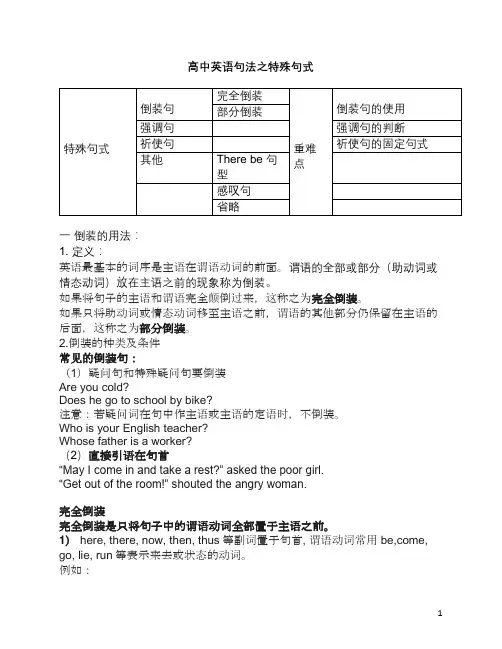
高中英语句法之特殊句式一倒装的用法:1. 定义:英语最基本的词序是主语在谓语动词的前面。
谓语的全部或部分(助动词或情态动词)放在主语之前的现象称为倒装。
如果将句子的主语和谓语完全颠倒过来,这称之为完全倒装。
如果只将助动词或情态动词移至主语之前,谓语的其他部分仍保留在主语的后面,这称之为部分倒装。
2.倒装的种类及条件常见的倒装句:(1)疑问句和特殊疑问句要倒装Are you cold?Does he go to school by bike?注意:若疑问词在句中作主语或主语的定语时,不倒装。
Who is your English teacher?Whose father is a worker?(2)直接引语在句首“May I come in and take a rest?” asked the poor girl.“Get out of the room!” shouted the angry woman.完全倒装完全倒装是只将句子中的谓语动词全部置于主语之前。
1) here, there, now, then, thus等副词置于句首, 谓语动词常用be,come, go, lie, run等表示来去或状态的动词。
例如:Here comes the bus! (=The bus is coming here! 用一般现在时表示正在进行的动作。
)There goes the bell! = The bell is ringing. 铃响了!Then came the chairman. 那时总裁来了。
Then came the hour we had been looking forward to.我们期盼的时候到了。
Here is your letter. 你的信。
2)表示运动方向的副词或地点状语置于句首,以out, in, up, down, off, away等副词开头,谓语动词是表示“移动”的go, come, leave等句子里。
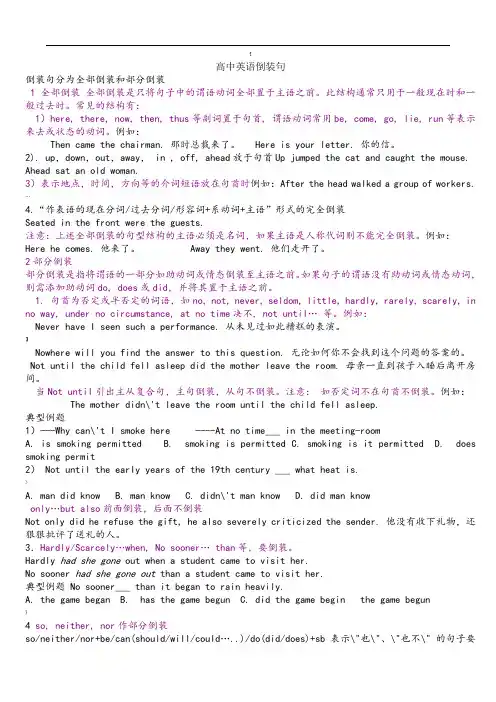
{高中英语倒装句倒装句分为全部倒装和部分倒装1全部倒装全部倒装是只将句子中的谓语动词全部置于主语之前。
此结构通常只用于一般现在时和一般过去时。
常见的结构有:1)here, there, now, then, thus等副词置于句首, 谓语动词常用be, come, go, lie, run等表示来去或状态的动词。
例如:Then came the chairman. 那时总裁来了。
Here is your letter. 你的信。
2). up,down,out,away, in , off, ahead放于句首Up jumped the cat and caught the mouse. Ahead sat an old woman.3)表示地点,时间,方向等的介词短语放在句首时例如:After the head walked a group of workers.…4.“作表语的现在分词/过去分词/形容词+系动词+主语”形式的完全倒装Seated in the front were the guests.注意:上述全部倒装的句型结构的主语必须是名词,如果主语是人称代词则不能完全倒装。
例如:Here he comes. 他来了。
Away they went. 他们走开了。
2部分倒装部分倒装是指将谓语的一部分如助动词或情态倒装至主语之前。
如果句子的谓语没有助动词或情态动词,则需添加助动词do, does或did,并将其置于主语之前。
1. 句首为否定或半否定的词语,如no, not, never, seldom, little, hardly, rarely, scarely, in no way, under no circumstance, at no time决不, not until… 等。
例如:Never have I seen such a performance. 从未见过如此糟糕的表演。
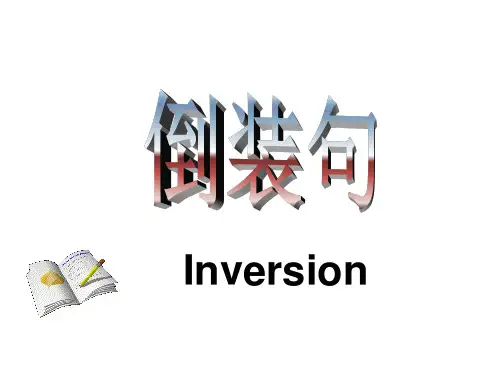
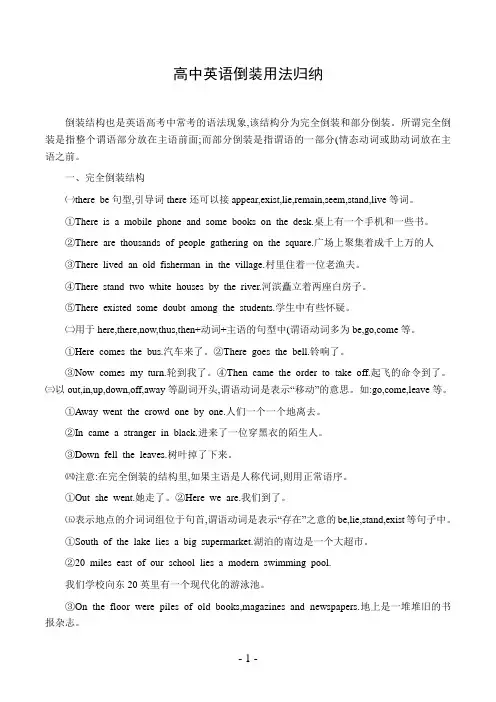
高中英语倒装用法归纳倒装结构也是英语高考中常考的语法现象,该结构分为完全倒装和部分倒装。
所谓完全倒装是指整个谓语部分放在主语前面;而部分倒装是指谓语的一部分(情态动词或助动词放在主语之前。
一、完全倒装结构㈠there be句型,引导词there还可以接appear,exist,lie,remain,seem,stand,live等词。
①There is a mobile phone and some books on the desk.桌上有一个手机和一些书。
②There are thousands of people gathering on the square.广场上聚集着成千上万的人③There lived an old fisherman in the village.村里住着一位老渔夫。
④There stand two white houses by the river.河滨矗立着两座白房子。
⑤There existed some doubt among the students.学生中有些怀疑。
㈡用于here,there,now,thus,then+动词+主语的句型中(谓语动词多为be,go,come等。
①Here comes the bus.汽车来了。
②There goes the bell.铃响了。
③Now comes my turn.轮到我了。
④Then came the order to take off.起飞的命令到了。
㈢以out,in,up,down,off,away等副词开头,谓语动词是表示“移动”的意思。
如:go,come,leave等。
①Away went the crowd one by one.人们一个一个地离去。
②In came a stranger in black.进来了一位穿黑衣的陌生人。
③Down fell the leaves.树叶掉了下来。
㈣注意:在完全倒装的结构里,如果主语是人称代词,则用正常语序。
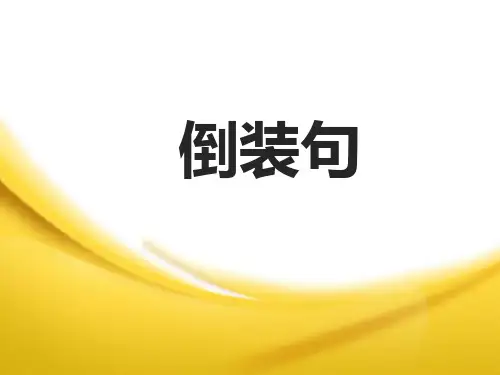
解密12特殊句式(强调,倒装,祈使句,感叹句等)考点详解【考点解读】1. 掌握倒装的必备条件及倒装的具体应用。
2. 熟知强调句的基本结构及其疑问句句式、特殊疑问句式,注意其与结构相似的主从复合句的区别。
3. 掌握省略的一些基本原则,在行文中正确地使用省略。
4. 掌握祈使句、感叹句的基本形式及用法。
5. 掌握反意疑问句的构成和用法。
【命题趋势】近两年高考试卷中的语篇型语法填空题对特殊句式的考查很少,但强调句型、倒装句、there be 句型等均为高中教学的重点内容,所以在高考备考中,考生仍然需要掌握这部分内容,以便有充分的知识储备和较强的综合能力应对高考。
考向1 倒装倒装是英语中常见的一种语言现象,它具有强调、修饰等作用。
倒装可分为完全倒装和部分倒装。
一、完全倒装完全倒装是指将句子中的谓语动词全部置于主语之前。
此结构通常只用于一般现在时或一般过去时。
常见的结构有:1. There be句型:其中be可换成live, lie, stand, remain, exist, come, go, seem (appear/ happen/ used) to be等表示"存在"意义的词。
☛There entered a strange little man. 走进来一个奇怪而身材矮小的人。
☛Once there lived an old fisherman in a village by the sea. 从前,海边的一个村子里住着一位老渔夫。
2. 以here, there, off, out, in, up, down, away, now, then, on等表示方向、位置或时间、地点的副词开头的句子,谓语是come, go, be等动词时,并且其主语为名词时,通常使用完全倒装。
☛Now, here goes the story. 现在,这个故事是这样的。
☛Then came another question. 然后又一个问题被提出来了。
英语倒装句倒装有两种:一将主语和谓语完全颠倒过来,叫做完全倒装。
如:In came a man with a white beard.二只将助动词(包括情态动词)移至主语之前,叫做部分倒装。
如:Only once was John late to class.英语句子的倒装一是由于语法结构的需要而进行的倒装,二是由于修辞的需要而进行的倒装。
前一种情况,倒装是必须的,否则就会出现语法错误;后一种情况,倒装是选择性的,倒装与否只会产生表达效果上的差异。
一完全倒装的四种主要类型(有地钻状洞动)1. here 和there、now、then位于句首时的倒装表示地点的here和there位于句首时,其后用完全倒装形式。
这类倒装句的谓语通常是动词be和come, go等表示移动或动态的不及物动词:Here’s Tom. 汤姆在这里。
There’s Jim. 吉姆在那儿。
Here comes the bus. 公共汽车来了。
There goes the bell. 铃响了。
There goes the last train. 最后一班火车开走了。
【注意】(1)以上倒装句中的谓语动词come和go不能用进行时态,即不能说Here is coming the bus。
(2) 若主语为代词,则不倒装:Here I am. 我在这儿。
/ 我来了。
Here it comes. 它来了。
(3) 其中的动词有时也可能是stand, lie, live等表示状态的动词(表示存在):There stood a desk against the wall. 靠墙放着一张书桌。
Once upon a time there lived a man known by the name of Beef. 从前有个人名叫比夫。
2. away和down等位于句首时的倒装地点副词away, down, in, off, out, over, round, up 等位于句首时,其后用完全倒装语序。
英语语法总结之倒装篇英语语法总结之倒装篇文章【摘要】:^p :倒装是高中语法中的一个重要知识点。
在英语中,倒装有很多种,在学习中要注意总结和区分。
根据语法要求,把谓语动词置于主语前,称为完全倒装,把助动词或情态动词置于主语前,称为局部倒装。
1.副词如:in, out, down, there, here, off, over, away, etc. 句子倒装。
〔完全倒装,但主语不能是代词〕Down jumped the murderer from the tenth floor.In came Miss Green.特别注意:当主语是人称代词时不倒装。
Away she went! 〔她走了!〕Here you are! 〔你在这儿!〕2.only + 副词〔介词短语〕位于句首,句子要倒装。
Only then did he realize that he was mistaken.Only by working hard can we succeed in doing anything.3.well, so, often, such, few, little 放于句首,句子形成倒装。
So fine was the weather that we all went out lying in the sun.Well did I know him and well did he know me.4.否认词或具有否认意义的词及词组用在句首时,句子须倒装。
此类词有: neither,nor,hardly,scarcely,rarely,seldom,not,never,not only,barely,at no time,nowhere等。
——Jack could not swim.——Neither could Tom.Never have I seen such a good movie.5.as引导让步状语从句,须倒装。
倒装句倒装的两种考法:1. 放在单项选择题中,考查考生的倒装语法知识是否熟练掌握;2. 放在完形填空和阅读理解中,设置理解障碍.倒装的两种形式:1. 完全倒装:将整个谓语动词提到主语前.2. 部分倒装:即半倒装,将谓语的一部分即助动词提到主语前.一、完全倒装1表方位的副词here, there 或out, in, up, down, away, off, over, back等标志词放在句首,句子用完全倒装.翻译句子1车来了. Here comes the bus.2铃响了. There goes the bell.3孩子们冲出来了. Out rushed the children.4那个男孩离开了. Away went the boy.疑难Here it is.In she came.Away he went.疑难剖析当主语是人称代词时,主谓语序不变.2地点状语放在句首且谓语动词为come, live, lie, go, sit, stand等时用完全倒装.完成例句5河的南面有一家小工厂.In south of the river lies a small factory. 6山谷里传来一声喊叫.From the valley came a cry.3 such, the following等放句首时,句子要完全倒装.翻译句子7Such are the facts. 情况就是如此.8生活就是这样. Such is life.9The following is the answer to the question. 这个问题的答案如下.4There lie / exist / stand / live +主语+…是there be 句型的变式翻译句子10山顶上有一幢高楼.There is a tall building on the top of the mountain.11山顶上耸立着一座古塔.There stands an ancient tower on the top of the mountain.5“表语+系动词+主语”的结构.例句观察Present at the party were Mr. Green and many other guests.出席晚会的有格林先生,还有一些别的宾客.Seated on the ground are a group of young men. 坐在地上的是一群年轻人.注意此时,主语较长,可还原为正常语序即:主+系动词+表语.二、部分倒装将情态动词、助动词、be提到主语前. 通常可以还原为正常的语序,并以此检验倒装句是否正确.1含有否定意义的副词或短语如:few, little, never, not, nowhere, rarely, seldom, at no time, by no means, in no case等放在句首时,需用部分倒装.翻译句子12Little does he know about the news. 他对这消息知之甚少.13By no means can he catch up in such a short time. 他根本不可能在这么短的时间里赶上来.疑难1He is active in personality, and he seldom stays indoors. 无助动词He is active in personality, and seldom does he stay indoors. 添加does疑难剖析1若原句中没有助动词,必须根据谓语动词的具体时态来确定相应的助动词do, does 或did.完成例句14—我有大量的工作要做.— I've got an enormous amount of work to do.—我也是.—So have I.15他,和他全家人一样,相信你是无辜的.He believed, as did all his family, that you were innocent. 16如果她不同意这个计划,Tom也不会同意.If she doesn‘t agree to the plan, neither will Tom.2so / as / neither / nor 为标志词放在句首时,句子用倒装.①表示前面所说的肯定情况,也适合于另一人或物时,句式如下:so / as + be 助动词或情态动词+主语.②表示前面所说的否定情况也适合于另一人或物时,句式如下:neither nor+ be 助动词或情态动词+主语.特别提醒①“so +主语+助动词或be动词”表示对上文肯定的内容加以肯定或赞同,意为“的确如此”;— It's raining hard. 天下着大雨.— So it is. 是的.②“主语+did +so”表示:“主语”这样做了. 例如:Tom asked me to go to play football with him and I did so. Tom要我去踢足球,我去了.3①“only +状语或状语从句”放在句首时,句子用部分倒装.②only之后跟的不是状语时不可倒装.完成例句17你只有用这种方法才能学好英语.Only in this way can you learn English well.18只有他有时间的话他才会来.Only if he has time will he come here. 19他被请了3次才来开会.Only after being asked three times did he come to the meeting.20Only that boy can work out the problem. 只有那个男孩才能解答出这个问题.21Only socialism can save China. 只有社会主义才能救中国.4在if引导的虚拟语气条件句中,从句谓语有助动词were, had, should 时,可将if 省略,而把 were, had, should 移到句首.翻译句子22如果我是你,我就不会那样做. Were I you, I wouldn't do that.特别提醒①若从句是否定句,则必须将 not放在主语后.② had必须是助动词.5在“so…that” 和“ such…that”结构中,将“so+adj. ”和“such+n. ”提到句首时,句子用部分倒装.完成例句23暴风雨如此厉害,整个屋顶都被吹掉了.So terrible was the storm that the whole roof was blown off. 24杰克是如此聪明的孩子,他能解答所有这些难题.Such a clever boy was Jack that he was able to work out allthese difficult problems.6often, always, once, many a time, now and then, every the other day, then等状语位于句首时,句子部分倒装.完成例句以前我经常提到他.Often did I speak of him.他常常帮助我做实验.Many a time has he helped me with my experiment.7在not…until…, no sooner…than…, scarcely/hardly…when,not only…but also…, neither…nor…,等否定词开头的句式中.完成例句约翰知道昨天才改变了主意Not until yesterday did John change his mind.她一坐下,电话就响了.Hardly had she sat down when the phone rang.他没去拜访她,他也不会这样做.Neither has he called on her,nor will he do so.她不但说的正确,而且说的流利.Not only did she speak correctly, but also she spoke fluently.8当as /though引导让步状语从句时,可出现“N/adj/adv/分词+as +S+V”或“V+as+S+助动词”的倒装形式.当表语是名词时,名词前不加任何冠词.完成例句尽管他们很勇敢,但这样的危险仍使他们感到畏惧.Brave as they were, the danger made them afraid.尽管他是孩子,但是他知道的很多.Child as he is, he knows a lot of things.虽然尝试了,但是她打不开门.Try as she might, she couldn’t get the door open.8当may 放句首,表达祝愿时,句子倒装.May you succeed.。
【高中英语】高中英语语法讲解:虚拟语气if倒装句省略连词if采用倒装的非真实条件句在书面语中,条件从句可以将过去时态were、had或should移到主语之前的谓语中,如果没有连词,就可以形成倒装句。
例:wereyouinmyposition,youwoulddothesame.如果你处在我的位置,你也会这么做。
要是他早点来的话,他就会见到她了。
虚拟语气在条件句中的应用非真实条件句中的条件从句有时不表示出来,只暗含在短语或上下文中,这种句子叫做储蓄条件句。
常见的有but,for,without等引导的短语,以及or,orelse,otherwise,but等后面的分句。
要不是你的帮助,我们不可能完成这个实验如果没有你的帮助,我们的实验室是不会成功的。
在更多可用条件下,我们本可以保存一个更好的在更有利的条件下,我们能够做得更好些。
经典测试地点:1、____rightnow,shewouldgetthereonsunday.a)她会离开吗b)ifsheleavesc) wereshetoleaved)ifshehadleft2、 ____________________________。
a)notbeingb)不是吗c)withoutbeingd)什么都没有3、wedidn’tknowhistelephonenumber,otherwisewe____him.a)我会打电话吗b)musthavetelephonedc)你会打电话吗d)hadtelephoned4、作为一种对目标的潜在的安全分析,不幸的是,它从来都不是。
a)wouldidentifyb)威利迪c)wouldhaveidentifiedd) willhaveidentified解析:1.答案是C。
从句子结构来看,这个问题是一个虚拟语气,与未来事实相反。
主句的谓语是“应该+动词原型”。
同时,该从句省略了连词if,它可以提前形成倒装句。
只有C符合语法规则。
倒装句一.概念:英语句子通常有两种语序:一种主语在前,谓语在后,称为自然语序,另一种谓误在前,主语在后,称为倒装语序二.相关知识点精讲:按“主语+ 谓语”这种顺序排列的句子是陈述语序。
如果排列顺序变为“谓语(或谓语一部分)+主语”,就是倒装。
倒装句分为:完全倒装:整个谓语移至主语前面叫完全倒装。
部分倒装:只把助动词、系动词或情态动词放在主语之前叫部分倒装。
1. 当以there, here, out , in , up , down, away 等副词开头的句子,为了起到强调的作用,可构成倒装句,只把副词放在句首,主语和谓语位置调换,不加助动词。
Our teacher came in. In came our teacher.这种倒装要求:主语必须是名词。
主语是人称代词时,主语和谓语语序不变。
Here it is. Away he went.这类倒装句式一般只用一般现在时和一般过去时。
Here comes the bus. Out rushed the boys.2. how, then, just, often 表示时间的副词放在句首,可构成倒装句,只把副词放在句首,主语和谓语位置调换,不加助动词。
Then came 8 years of the Anti Japanese War.3. 表地点状语的介词短语放在句首,要用倒装句式,以示强调。
这种倒装句也是主谓直接调换位置,不加助动词did, does或do.Under a big tree ________, half asleep.A. did sat a fat manB. a fat man satC. did a fat man satD. sat a fat man4. there放在句首时,要用倒装句式。
在“there + be”结构中的谓语动词有时不用be , 而用表示类似“存在”观念的其他不及物动词。
如:live, stand, come, lie, flow, enter, rise 和appear等。
There came shouts for help from the river.There lies a large wheat field in front of the house.Many years ago there lived an old man in the wooden house.In front of the tower flews a stream.5. so + 动词+主语neither/ nor + 动词+主语表示两人的同样一个情况时,只能表示一件事,即上、下句所使用的动词、时态要一致。
否则要用so it is with…You can ride a bike. So can I . He has been to Beijing. So have I .The first one isn’t good, neither is the second.His uncle is a worker and has been working in the factory for more than ten years. So it is with his aunt.6. so+ 形容词/副词that 的结构状语从句可以用正常语序表示,也可以把so+形容词/副词放于句首构成倒装。
句型如下:so +形容词/副词+be/助动词/情态动词that +从句。
Light travels so fast that it is difficult for us to imagine its speed.= So fast does light travel that it is difficult for us to imagine its speed.So easy was the work that they finished it in a few days.7. done做形容词在句中做表语时,常把表语放在句首,要用倒装句式。
Gone forever are the days when the Chinese people had to use foreign oil.8. 否定副词not , never, seldom, nowhere, little , rarely 放于句首时要用倒装句式。
We seldom get up at four in the morning.= Seldom do we get up at four in the morning.Not a single word from him could the enemy drag.Rarely have I heard of such a silly thing.9. hardly…when; scarcely…when…; no sooner…than…可以用正常语序had hardly done when…did 或用倒装句式Hardly had + 主语+ done when…did 句式。
hardly所在的句子用过去完成时。
The bell hardly had rung when the class began.= Hardly had the bell rung when the class began.No sooner had he arrived in Beijing than he began to work.10. not only…but also 如连接两个成分时,不用倒装;连接句子时,前面的句子要用倒装。
Not only was everything that he had taken away from him, but also his German citizenship.Not only is he busy, but also I have a lot of work to do.Not only does he speak English very well, but also he speaks French well.11. only 及所修饰的副词、介词短语或状语从句放在句首时,要用:only+ 状语+ be /助动词/情态动词+主语及其他Only when he told me the news did I know what had happened.Only in this way can you make progress in your English.12. 虚拟语气中的倒装句If I were you, I would take the job. = Were I you, I would take the job.练习:1._______ and caught the mouse.A. Up the cat jumpedB. The cat up jumpedC. Up jumped the catD. Jumped up the cat2.______ and the lesson began.A. In came Mr. BrownB. Mr. Brown in cameC. In came heD. came in Mr. Brown3.Over _______ , dead.A. rolling the goatB. rolled the goatC. did the goat rollD. the goat rolled4.—Where is my shirt, mum? —_________.A. There is itB. There it isC. There isD. Here is it省略句一. 概念:英语中,为了避免重复,常常省略句子中的一个或几个成分,这样的句子叫省略句二.相关知识点精讲:1. 简单句中的省略:在对话中,交谈双方都知道谈论的对象,则可以省略句子的主语,省略主语和谓语的现象在交际用语中出现的很多。
(1)Looks like rain.(2)Hope to hear from you soon.(3)Sounds like a good idea.(4)Beg your pardon.(5)Feeling better today ?(6)This way, please.(7)—What does he want to eat ?—Some rice and vegetables.(8)Anything I can do for you ?(9)Sorry to hear that.(10)Doesn’t matter.(11)Terrible weather!(12)Pity you couldn’t come.2. 并列句中的省略:在并列句中,相同的成分如主语,谓语,宾语等都可以省略:(1)They learn French and we English.(2)My father planned and built all these houses.(3)John won the first race and Jimmy the second.(4)Coral is not a plant but a variety of animal life.3. 复合句中的省略:定语从句:(1)That’s the reason he is late for the conference.(2)I don’t like the way he talks.状语从句:(1)If heated, water will boil.(2)Tom was attacked by cramp while swimming across the river.(3)We’ll go to help you if necessary.(4)Had I time, I would come.(5)I’ll go, should it be necessary.(6)The captain can find a boat quicker than we can.宾语从句:如果宾语从句中的谓语部分与主句的谓语部分或上文的谓语部分相同,可将从句部分的谓语省略。
(1)We will do what we can(do)to help you.(2)—Is Mr. King in his office?—Sorry, I don’t know(whether he is in his office or not.4. 动词不定式的省略:在动词不定式结构中,为了避免重复,常常省略不定式结构中的动词原形,只保留to。